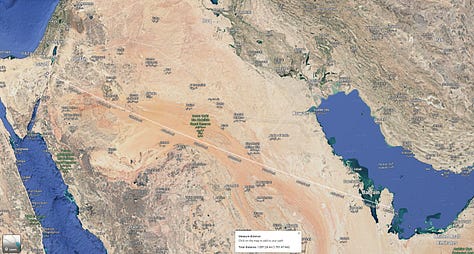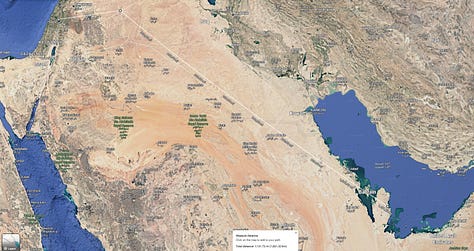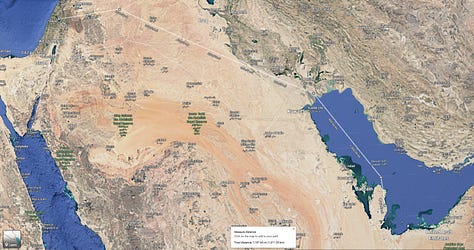Deciphering Early Reports About Israel's Air/Missile Attack In Doha, Qatar
🇮🇱 🇶🇦 🇺🇸
Note: The following text was originally posted on my X/Twitter account.
Some observations regarding the reported Israeli airstrike in Qatar earlier today:
Israeli media reports indicate the use of 10+ Israeli air force fighter aircraft of unknown type and 10+ munitions of unknown type. Available images and videos suggest the use of smaller/lighter munitions. One candidate munition is the (American-built) GBU-39 Small Diameter Bomb (SDB), which has the advantage of offering a considerable standoff range, or even smaller/lighter. Note that while we do not currently know, the Qataris will likely find out—if they have not already—as there will be debris from the munitions used in the attack. Candidate aircraft are F-15I strike fighters and F-35I low-observable fighters. The F-16I fleet is also a possibility, but that aircraft type is more limited in terms of payload-range. Assessing the performance of Qatari air defences and those of other Gulf Arab states more generally requires information on the munitions and aircraft employed in the reported Israeli airstrike, as well as information on the flight path of Israeli aircraft—more to follow.
Supposing that Israeli media reports—which are, of course, sourced from the Israeli military and the Israeli government more generally—are accurate, I am unsure of the advantage of using 10+ fighter aircraft to release what appears to have been a small number of small/light munitions. The two-way flight distance from Israel to Qatar is immense—more to follow— and this reduces the practical payload of Israeli fighter aircraft even with aerial refuelling en route. We are likely dealing with a situation in which multiple Israeli fighter aircraft—of unknown type—were primarily, if not exclusively, equipped with a small number of air-to-air missiles to escort the aircraft equipped with the air-to-ground munitions. Note, however, that Israeli planners likely built some redundancy into the strike package. I would not be surprised if a larger percentage of involved Israeli fighter aircraft flew part of the route and turned back, likely while within Syrian or possible Iraqi airspace—more to follow.
There is a lot of discussion as to what the United States and Donald Trump did and did not know and when, and what the United States and Donald Trump did/did not do—or try to do—about it, supposing that Israel provided advance notice. In any event, today's incident reflects poorly on Qatar's military despite the tens of billions of dollars Qatar has spent on providing it with a (rather irrationally) diverse array of the latest armaments primarily sourced from the United States and Europe. While I will wait for additional information as to how Israel carried out this apparent airstrike against such a distant target, I am inclined to think that Israeli aircraft launched munitions over the Persian Gulf, which is to say from a direction/threat axis that should have been surveilled and covered by Qatar's air and ballistic missile defences.
Supposing that Israeli aircraft were flying over the Persian Gulf, these should have also been detected by Iraqi, Saudi, Kuwaiti, and Bahraini air defences, as well as by forward-deployed American military units based in the Gulf Arab states (independent of the timing and nature of the advance notice that Israel is reported to have provided the White House). Note that we do not know what the United States did with any advance notice, including whether American military units—including both air defence systems and fighter aircraft—based at al-Udeied Airbase outside Doha were placed on alert. If this incident had happened a decade or so earlier—especially in Doha, Qatar, given the aerial blockade-type situation that Qatar encountered for a time—there would have been limited coordination among the Gulf Arab states. In recent years, however, the Gulf Arab states are reportedly to have greatly increased coordination in air and ballistic missile defence—through United States Central Command's (CENTCOM) 609th Air Operations Center (AOC), which is located at al-Udeid Airbase in Qatar, which serves as the hub for these arrangements. It should be noted that American and Israeli reports in the aftermath of Iran's single-day April 2024 cruise missile, propeller-driven strike drone, and ballistic missile attack on Israel indicated that there was some level of coordination—at least the sharing of sensor coverage—between at least some Gulf Arab states and Israel via CENTCOM. This was, in part, made possible by the transfer of Israel from the United States European Command (EUCOM) to CENTCOM in 2021 following the 2020 Abraham Accords, which did not include Qatar.
What route did Israeli fighter aircraft take? Supposing that Israel did not fly through Jordanian and Saudi airspace without permission—and supposing that neither Jordan nor Saudi Arabia would have permitted Israeli fighter aircraft to fly through their territory, the most likely flight path was northern Israel-->Syria-->Iraq. I am inclined to think that Israel would have avoided Kuwait airspace—Kuwait is also home to a considerable American military presence—but hosting American military forces does not appear to carry much weight these days. Israeli aircraft may have flown over the narrow section of Iraqi territory with access to the sea and thereafter flown over the Persian Gulf. We do not know which munitions were used and, as such, the standoff range of said munitions. It is, therefore, currently difficult to say whether Doha was attacked from the west, north, or east. In any event, such a route would entail over 1900 kilometers of flight. Depending on the munitions used, the flight distance would have been reduced to some extent or another.



Unless Israel employed air-launched ballistic missiles or very long-range air-launched cruise missiles, the primary alternative to the above flight path would entail flying in Saudi airspace, including highly surveilled and—ordinarily—well-defended sections of Saudi airspace—most of Saudi Arabia's oil and natural gas extraction facilities are in the country's east and relatively close to the Persian Gulf. Note that we are still dealing with a flight distance of over 1800 kilometers. Another possibility is a flightpath that originated in southern Israel and included transiting through both Jordanian and Saudi airspace. Not that we are still dealing with a flight distance of over 1700 kilometers.
As with most events, we know very little about what transpired at this time. Anyone operating with publicly available information encounters considerable uncertainty. As I said in a recent post on another subject, it can take weeks if not months to (imperfectly) reconstruct what transpired, let alone divine the immediate and longer-term implications of what little is known about recent/ongoing events. Sobriety, cognizance of uncertainty, and intellectual humility are in order.
Update:
There is new information on the Israeli air/missile strike targeting HAMAS' political leadership in Doha, Qatar, from the Wall Street Journal. Key points for anyone interested in the military aspect of the Israeli operation:
"More than 10 Israeli jet fighters fired long-range munitions at the house, causing explosions heard across the capital."
"Israel assigned at least 10 warplanes to the operation, each carrying long-range “over the horizon” missiles that could hit their targets from a safe distance."
"The distance from Tel Aviv to Doha is well over 1,000 miles. But the jets could get close enough to use long-range guided missiles without flying directly over the sensitive airspace of Saudi Arabia or the United Arab Emirates."
"As the jets moved in to strike, Israel’s military told their American counterparts that an attack on Hamas targets was coming minutes before missiles were launched but didn’t disclose an exact location, according to U.S. officials. The U.S. military officials saw the missiles launch and inferred the target."
"The Israeli planes launched more than 10 missiles at Hamas’s Doha offices from outside Qatari airspace."
There are multiple candidate long-range "over the horizon" standoff munitions that Israel could have used—Qatari officials will have likely made a determination based on debris at the impact sites. Given how the Wall Street Journal characterizes the United States' ability to "see" the missiles launch, I would not be surprised if Israel used air-launched ballistic missiles—broadly defined—of one sort or another that were detected by American Space-Based Infrared System (SBIRS) satellites, which have infrared-band sensors that can detect the infrared signatures of highly energetic missile boosters. It is worth noting that Qatar is home to a very high-end American-built AN/FPS-132 UHF-band ballistic missile early warning. This radar is understood to be highly integrated with United States Central Command's (CENTCOM) Combined Air Operations Center, which is located at al-Udeied airbase outside Doha.
There are at least two ways to interpret the following text: "But the jets could get close enough to use long-range guided missiles without flying directly over the sensitive airspace of Saudi Arabia or the United Arab Emirates." The first option is that Israeli aircraft flew over the Persian Gulf, which would allow launches against Doha without flying directly over Saudi (let alone Emirati) airspace. The other option is that Israeli aircraft flew over the Red Sea and targeted Doha from the ~southwest. Depending on which air-launched munition the Israeli aircraft launched, such an operation may have entailed flying over Saudi territory.
Future reporting may reveal the flight path taken by the Israeli fighter aircraft and which countries' airspace was transited, whether wittingly or unwittingly. This will, in turn, allow us to eliminate some of the candidate—publicly known—Israeli air-launched munitions that may have been used in this very long-range aerial operation.
Additional points that I made in the comments:
Qatar does not currently operate THAAD batteries—only the UAE and Saudi Arabia have received THAAD batteries at this time. I suspect most of Qatar's Patriot batties and associated MPQ-65 radars are oriented toward Iran following the June 2025 Iranian ballistic missile attack on American forces at al-Udeid Airbase, and given the limited threat posed by Ansarallah in Yemen to Qatar relative to other Gulf Arab countries.
Qatar's AN/FPS-132 ballistic missile early warning radar has three faces offering a 360° field of view. Any air-launched ballistic missiles used in the attack were presumably detected by the AN/FPS-132 radar. The extent of early warning will have been determined by the distance at which any air-launched ballistic missiles were launched.

